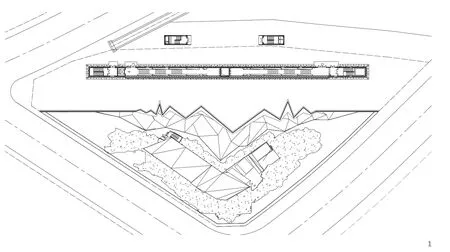玉树抗震救灾纪念馆,玉树,青海,中国
主持建筑师:孟建民
玉树抗震救灾纪念馆,玉树,青海,中国
主持建筑师:孟建民
2010年4月14日上午7时49分,青海省玉树藏族自治州玉树县发生7.1级地震,遇难人数达2600多人。中国建筑学会随后代表建设部为玉树重建组织了一次建筑师的集群设计,我也有幸参加并创作了玉树抗震救灾纪念馆。
基地位于结古镇的南入口格萨尔王宾馆遗址旁边,成为进出玉树的必经之路。方案以保留的格萨尔王宾馆遗址为展示主体,纪念馆主体隐于地下。新旧建筑“一隐一显”,通过控制地面体量,尽可能突出遗址本身的视觉震撼力和纪念意义。地面通过两条线性元素进行限定,两者之间围合的广场是举行仪式集会的纪念场所。贯穿场地的折线形 “裂痕”作为采光缝限定出遗址保护范围,同时建立起遗址与地下展厅的视觉联系。极简的直线形纪念长墙以暖色毛石制成,直指结古寺。长墙不仅隐含着内在精神寓意,同时作为遗址的背景与远方群山相融。沿着墙体设计的85个转经筒,成为人们进出玉树时的标志性建筑部分,在纪念馆转经祈福也成为当地藏民宗教生活的重要组成部分。
建筑主体藏于地下,以纯粹的“方”和“圆”为基本原型。方案采取地域建筑设计策略,通过“材料、色彩、光”3种基本建筑要素的运用,表达藏地建筑特色。内部空间采用青色毛石、素混凝土、藏红色耐候钢板等现代材料营造内敛而庄重的空间氛围。当人们通过线性空间序列缓缓进入中央的祈福之庭,内聚的圆形空间和环绕的壁龛矩阵试图唤起观者内心的精神共鸣,把沉重的灾难记忆转化为对生命的祈福,传达出人与自然和谐共生的生命哲学。

1 首层平面/Floor 0 plan

2 地下一层平面/Floor -1 plan

3 剖面/Section
项目信息/Credits and Data
场地面积/Site Area: 6303m2
建筑面积/Floor Area: 2998m2
设计时间/Design Period: 2010
竣工时间/Completion: 2013
At 7:49 am on April 14, 2010, an earthquake struck Gyêgu in the Yushu Tibetan Autonomous Prefecture of Qinghai and registered a magnitude of 7.1 Ms, killing over 2600 people. On behalf of the Ministry of Construction, the Architectural Society of China promptly organized a collective design team for the reconstruction of Yushu. I was honored to join the expedition and design the Memorial of Earthquake Ruins.
The site is located at the south entrance of Gyêgu near the remains of King Gesar Hotel, which becomes the only route to enter and exit Gyêgu. The design takes the preserved hotel remains as the object of exhibition, while the main part of the memorial is hidden underground. The old-new contrast – one exposed, the other hidden – aims to give utmost prominence to the striking visual effects and commemorative significance of the remains. The ground level is defined by two linear elements that embrace a square to be used for commemorative rituals and gatherings. A broken line of "crack" passing through the site defines the preservation extent of the remains and functions as a lighting seam, meanwhile establishing a visual connection between the remains and the underground exhibition hall. The long memorial wall in simplistic straight line is built up with warmcolored rubbles, pointing directly towards the Gyêgu Monastery. The long wall not only implies an inner spiritual meaning, but also merges into the distant mountains as the backdrop of the remains. 85 prayer wheels are devised along the wall – an architectural landmark for people entering and exiting Gyêgu; wheel praying at the memorial has become an important part of local Tibetans' religious life.
The main part of the building is hidden underground, taking the pure forms of "square" and "circle" as its basic geometry. The design adopts a regionalist approach, and expresses characters of Tibetan architecture through the application of three fundamental architectural factors, namely material, color, and light. The interior space creates an introspective, sublime atmosphere in its use of such modern materials as cyan rubbles, plain concrete, and saffron-colored COR-TEN steel. Slowly passing through the linear spatial sequence and entering the central praying court, the visitor's spiritual resonance is gradually evoked by the embracing circular space and the surrounding matrix of niches; traumatic memories are transformed into life's prayers, conveying the life philosophy of interdependence and harmony between man and nature.
Yushu Memorial of Earthquake Ruins, Yushu, Qinghai, China, 2013
Principal Architect: MENG Jianmin

4 外景/Exterior view

5.6 内景/Interior view

7 外景/Exterior view

